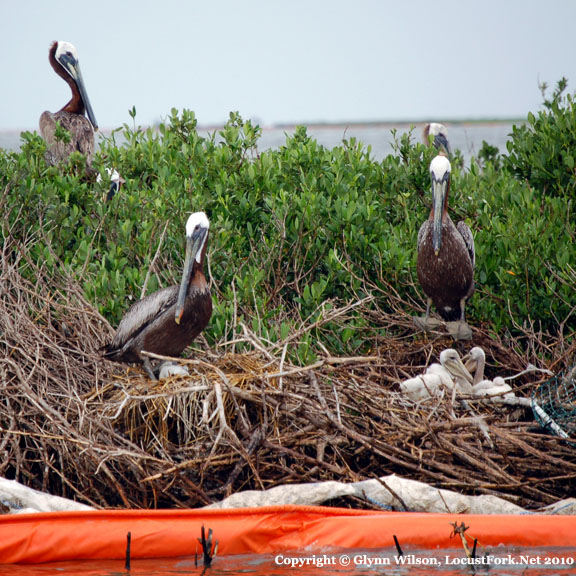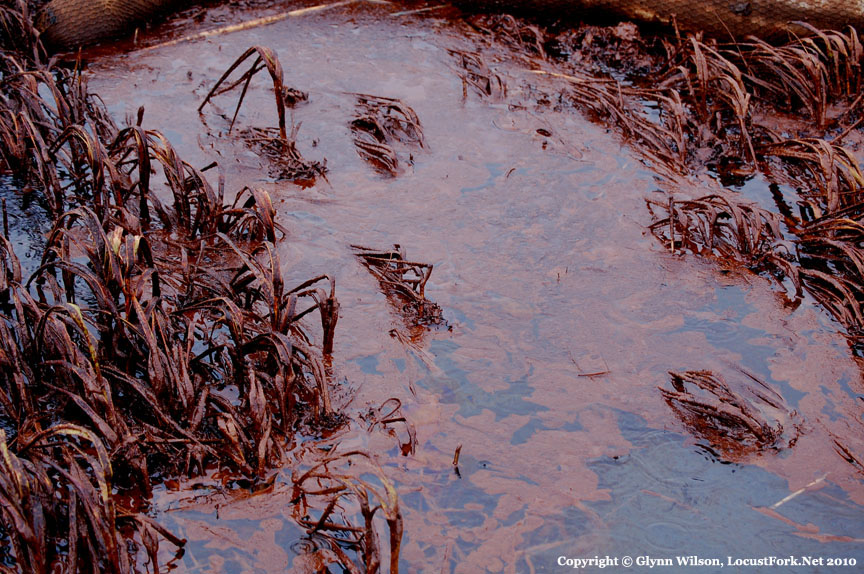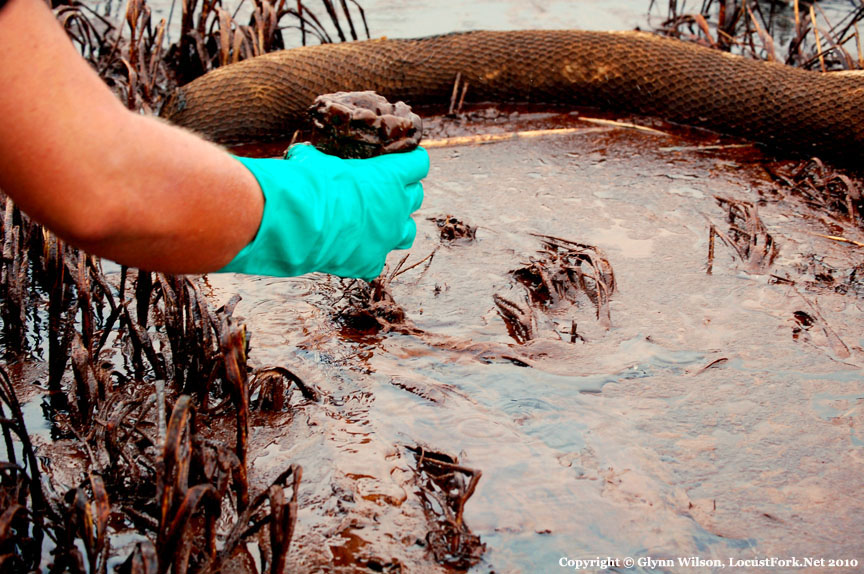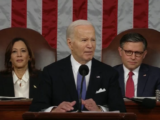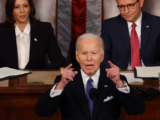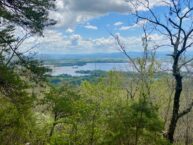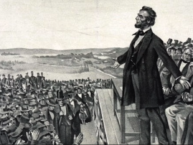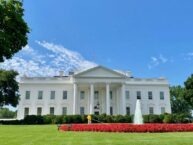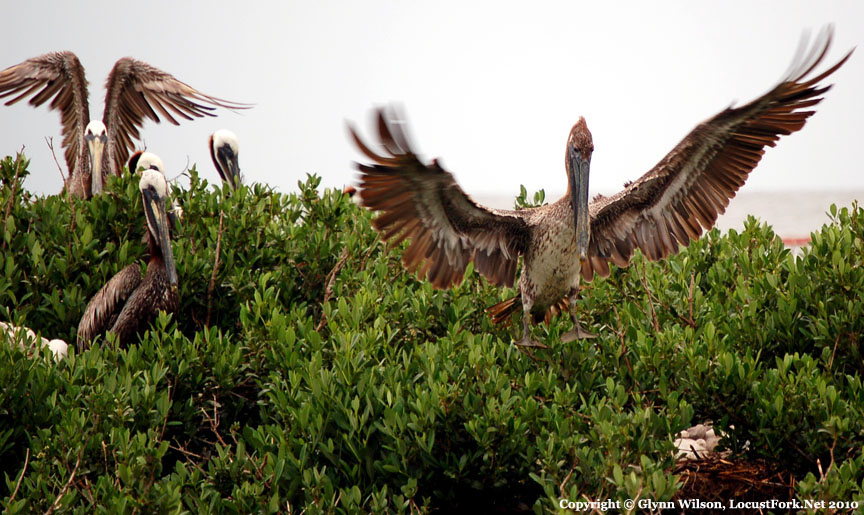
Brown pelicans with young and eggs on an island surrounded by BP oil in Barataria Bay Louisiana, June 2010: Glynn Wilson
By Glynn Wilson –
It was July 5, 2010, while BP’s Deepwater Horizon was still gushing into the Gulf of Mexico and I was watching helpless from Gulf Shores, Alabama, that I began to ask the question:
Where Oh Where Have All the Wildlife Gone?
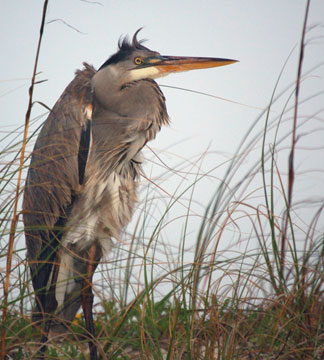
A great blue heron on West Beach in Gulf Shores looked shell-shocked as the wind carried the smell of BP’s spilled oil in June, 2010: Glynn Wilson
Are most of the birds already dead from the oil, their carcasses at the bottom of the sea?
Are some species smart enough to sense the deadly stew of oil and chemical dispersants and move inland?
Or are contractors hired by BP out there working the beaches at night, collecting dead animals and not reporting them, so the tourists won’t have to see them in the morning and the company may escape some liability in this multi-billion dollar disaster?
According to official estimates, about a half a million birds died in the area around Prince William Sound, Alaska in 1989, when 11 million gallons of oil spilled into the sea from the Exxon Valdez super tanker.
Yet as of July 4, two months and two weeks after the Deepwater Horizon exploded and sank into the Gulf of Mexico, the official government report on dead wildlife in the Gulf from BP’s oil spill only records the collection of 2,289 birds, 1,359 dead and 930 alive. Only 408 have been released alive, even though experts acknowledge many of those will not survive the trauma.
The same report shows only 58 mammals, mostly dolphins, have been reported. Of those, 53 were dead and five were found alive. Only one has been released alive.
“This is just the tip of the iceberg,” according to Birders United. “Scientists estimate that only 10 percent of oil-soaked birds are ever found. Most of the oil-soaked bird carcasses sink to the bottom of the sea.”
Now, finally, a team of scientists has tried to quantify the extent of damage inflicted on the Gulf’s bird population from the oil spill caused by the explosion. Based on models using publicly available data, the studies estimated that about 800,000 birds died in coastal and offshore waters.
“Part of the reason they discovered so few carcasses is because the oceanographic currents for the most part moved them away,” said Jeffrey Short, a marine chemist and a co-author of the studies.
The findings are bound to be disputed. The science of calculating the number of birds affected in such a catastrophe remains imprecise, and studies by BP and the federal government are not yet publicly available for comparison.
The studies also illustrate the difficulty of calculating a death toll in geographically difficult circumstances — and of establishing a figure that is widely accepted, particularly amid legal battles.
Dr. Short and two colleagues conducted the studies for two law firms representing clients with environmental impact claims against BP stemming from the explosion of the rig on April 20, 2010.
Dr. Short spent most of his 31-year career with the National Oceanic and Atmospheric Administration studying the 1989 Exxon Valdez spill in Alaska and mired in resulting lawsuits. Chris Haney, another of the authors, is the chief scientist for Defenders of Wildlife, which has been involved in lawsuits against BP.
In a statement, Jason Ryan, a spokesman for BP America, questioned the objectivity of the researchers. He also questioned their methodology, arguing that some of the authors’ assumptions are not supported by data collected for the Deepwater Horizon Natural Resource Damage Assessment, a collaborative effort by the responsible parties and the federal government that is required after major oil spills.
While the damage assessment studies are not complete, “analysis of field observations conducted to date indicate that population and nesting impacts from the spill on birds were limited,” said Mr. Ryan.
While the ratio of deaths to carcasses varies from spill to spill, it is typically estimated at 10 to 1 or lower. But Dr. Short’s research, to be published in the journal Marine Ecology Progress Series, makes the case for a significantly higher ratio for the gulf spill.
But some researchers say circumstances in the gulf can make carcass recoveries particularly low — among them prevailing winds and currents, as well as the disappearance of bodies before they reached shore because of factors like controlled surface oil fires, tiger sharks and decay rates in sweltering heat. And the search area encompassed more than 4,000 miles of coastline.
Jordan Karubian, a bird ecologist at Tulane University in New Orleans, said he found the estimates reasonable. “Given the degree of uncertainty we’re dealing with inherently in the process, my sense is that these researchers were careful to be conservative.”
The new studies were based on two established modeling techniques to overcome the challenges. A primary study estimated bird deaths in coastal waters within 25 miles of shore, which was assumed to be the farthest a carcass could drift before disappearing. Using public data on the number of dead birds found during and after the spill, they calculated the likelihood of finding a given bird by factoring in daily winds and currents, carcass drift speeds and carcass disappearance rates on shorelines from decay and scavenging, among other parameters.
The team considered only carcasses of coastal species that spend time over or in the water, such as gannets and pelicans, and that were visibly oiled.
The carcass count then dropped to 2,004 from the initial 3,000. By comparison, a recent California spill 1,000 times smaller than Deepwater Horizon yielded 1,500 carcasses.
The team’s second coastal model used data on the locations of oil slicks on each day during the spill and several days afterward. They also studied data on the numbers and habits of birds typically found offshore. The model calculated the likelihood that a bird would land in oil, an event likely to kill it by interrupting feeding patterns or causing other complications. Multiplying that probability by the estimated birds present yielded the second death estimate.
The researchers found both results to be similar despite the uncertainties and the divergent methods. The first model estimated about 600,000 deaths, with an uncertainty range of 320,000 to 1.2 million birds. The second model estimated 800,000 deaths with an uncertainty range of 160,000 to 1.9 million.
For a companion paper to be published soon, the authors used another model to estimate likely bird deaths farther than 25 miles offshore, where sooty terns and band-rumped storm petrels, among other species rarely seen from land, could be found. They estimate there were 120,000 deaths, with the uncertainty range at 25,000 to 400,000.
By comparison, the still-contested estimate in the much smaller Exxon Valdez spill was about 300,000, with an uncertainty range of 100,000 to 690,000.
Beyond counting the dead, researchers say a major challenge will be determining what, if any, long-term effects the losses will have on the area’s ecology.
Melanie Driscoll, an ornithologist with the Audubon Society in Baton Rouge, La., said the work has “tremendous value” for restoration planning. But, she said, “this is a really big number, and it’s still too small.” The study didn’t consider categories such as marsh birds.
Dr. Short’s team tested its results by comparing them with an independent source of bird data, an annual Audubon Society citizen science event called the Christmas Bird Count. The researchers had teased out of their aggregate numbers the impact on some species. They estimated that 40 percent of northern gulf laughing gulls had died, for instance.
The issue is not disputes between scientists and company officials about exactly how many birds died. The oil rig explosion and massive release of oil should not have happened. It didn’t have to happen. Conclusive studies have demonstrated that deregulation and an attitude on the part of the conservatives in charge of the federal government that oil companies should be able to do whatever they want to generate energy was as much to blame as anything else for the largest and worst environmental disaster to date in American history. A lot of wildlife died as a result.
The real questions are: When will we learn the real lessons from such a disaster? And when will we take appropriate actions to ensure nothing like that ever happens again?


